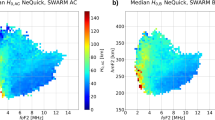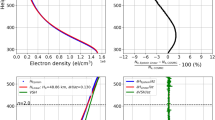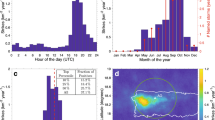Abstract
DURING the period between ground sunset and ionospheric sunset, the solar light is considerably filtered during its passage through the entire atmosphere before reaching still-illuminated ionospheric regions. Most of the ionizing radiation is absorbed before it reaches the illuminated regions, hence only some heating might be caused by the long-wavelength spectrum of the incident radiation. It seems reasonable, however, to expect that topside regions are thermally stable because they have been illuminated for a long period of time.
This is a preview of subscription content, access via your institution
Access options
Subscribe to this journal
Receive 51 print issues and online access
$199.00 per year
only $3.90 per issue
Buy this article
- Purchase on Springer Link
- Instant access to full article PDF
Prices may be subject to local taxes which are calculated during checkout
Similar content being viewed by others
References
Arendt, P. R., and Soicher, H., Nature, 220, 459 (1968).
Arendt, P. R., Rosati, V., and Soicher, H., Quick-Look System for Virtual Real Time Reception of Topside Ionograms, Special Issue Proc. IEEE on Topside Sounding (in the press).
Chan, K. L., Radio Sci., 1, 1158 (1966).
Author information
Authors and Affiliations
Rights and permissions
About this article
Cite this article
ARENDT, P., SOICHER, H. Topside Ionospheric Structure at Northern Mid-latitudes after Ground Sunset in Summer. Nature 222, 1155–1156 (1969). https://doi.org/10.1038/2221155a0
Received:
Revised:
Issue Date:
DOI: https://doi.org/10.1038/2221155a0
Comments
By submitting a comment you agree to abide by our Terms and Community Guidelines. If you find something abusive or that does not comply with our terms or guidelines please flag it as inappropriate.



